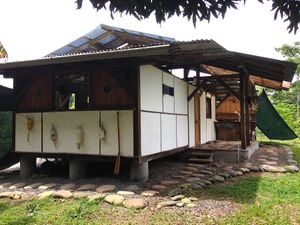Green building

Green building is the practice of increasing the efficiency with which buildings use resources — energy, water, and materials — while reducing building impacts on human health and the environment, through better siting, design, construction, operation, maintenance, and removal — the complete building life cycle.
A green building minimizes impact on the environment through resource conservation in the choice of materials, construction methods, and ongoing consumption. Avoiding artificial compounds and managing ventilation can also contribute to the health of its occupants.
Perhaps the least obvious benefit, yet an extremely important one, is comfort. By reducing the need for air conditioning and heating, and by using natural light, natural materials and natural ventilation, green buildings tend to be aesthetically pleasing, texturally rich, fresh and pleasing environments,
Implementing a building management system, a of computer networking of all energy-related mechanisms of the building, can greatly decrease the need for all forms of energy[verification needed] and improve comfort. This is the concept of the "intelligent building".
Alternative building[edit | edit source]

Alternative building refers to construction methods that differ from mainstream modern architecture. They often use natural building materials, with a strong emphasis on sustainable design. Recently, popular housing materials, such as treated lumber, synthetic insulation and certain paints (to name a few) have been exposed as harmful to both the environment and the inhabitants of the houses. There is no dispute over this issue; anyone who cares to ask will find that treated lumber releases the preservatives and poisons which it was soaked in over a predictable period of time. This is where alternative construction comes in.
While green buildings most often include high technology as part of their design, alternative buildings more often depend on traditional designs (reflecting wisdom which has evolved over many generations) and creative use of locally available materials and limited resources. Indeed, some would say that "alternative building" is quite an odd phrase, considering that the strategies used to conserve energy and materials have been documented for millennia in some cases. Practices such as adobe, wattle and daub, mud-brick, rammed earth, earth bag and straw bale housing construction are alive and well. In many instances the houses are less expensive to build and maintain, healthier to live in and more sturdy and reliable than those made from "conventional" materials.
Ecovillages[edit | edit source]

Ecovillages are a kind of sustainable neighbourhood, which are typically planned and managed cooperatively. They are intended to be socially, economically and ecologically sustainable intentional communities[1][2] - though they include models that may be less intense and offer more privacy than some intentional communities. Compared to sustainable cities, they are smaller and typically aim for a population of no more than 150 individuals, which is considered to be the maximum social network according to findings from sociology and anthropology (Hill & Dunbar, 2002). However, cooperative networks of ecovillages do exist.
Ecovillage members are united by shared ecological, social or spiritual values (see Intentional community). An ecovillage is often composed of people who have chosen an alternative to centralized power, water, and sewage systems. Many see the breakdown of traditional forms of community, wasteful consumerist lifestyles, the destruction of natural habitat, urban sprawl, factory farming, and over-reliance on fossil fuels, as trends that must be changed to avert ecological disaster. They see small-scale communities with minimal ecological impact as an alternative.
In 1991, Robert Gilman set out a definition of an ecovillage that was to become a standard. Gilman defined an ecovillage as a settlement:
Certifications[edit | edit source]
LEED[edit | edit source]
LEED is The Leadership in Energy and Environmental Design (LEED) Green Building Rating System, developed by the U.S. Green Building Council (USGBC), provides a suite of standards for environmentally sustainable construction. It's a green certification system used in the United States, with different levels of certification for green buildings based on different criteria and total credits and points earned.
Credits are given based on:
- Sustainable sites
- Water efficiency
- Energy and atmosphere
- Materials and resources
- Indoor environmental quality
- Innovation and design process
Different certification levels are based on the amount of points a building receives for successful attempts at the six categories.
See also[edit | edit source]
External links[edit | edit source]
- Wikipedia:Green building
- Green Building Breakthrough:Engineering A Sustainable World
- Green and sustainable Building Resource site
- 21 Leading Green Experts Give Their Best Sustainable Tips
- Green Home Building - (sustainable architecture and natural building)
- ECO Buildings That Are Saving The Environment
- A Green Origin for Renewable Energy
- Climate Change Resilient Infrastructure